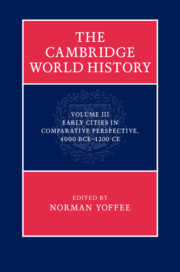Crossref Citations
This Book has been
cited by the following publications. This list is generated based on data provided by Crossref.
Fernández-Götz, Manuel
and
Krausse, Dirk
2017.
Eurasia at the Dawn of History.
p.
3.
Bajema, Marcus
2017.
Variation on a theme: Mycenaean early civilisation in a comparative perspective.
Journal of Greek Archaeology,
Vol. 2,
Issue. ,
p.
81.
Urciuoli, Emiliano Rubens
and
Rüpke, Jörg
2018.
Urban Religion in Mediterranean Antiquity: Relocating Religious Change.
Mythos,
p.
117.
Fernández-Götz, Manuel
2018.
Urbanization in Iron Age Europe: Trajectories, Patterns, and Social Dynamics.
Journal of Archaeological Research,
Vol. 26,
Issue. 2,
p.
117.
Green, Adam S.
Orengo, Hector A.
Alam, Aftab
Garcia-Molsosa, Arnau
Green, Lillian M.
Conesa, Francesc
Ranjan, Amit
Singh, Ravindra N.
and
Petrie, Cameron A.
2019.
Re-Discovering Ancient Landscapes: Archaeological Survey of Mound Features from Historical Maps in Northwest India and Implications for Investigating the Large-Scale Distribution of Cultural Heritage Sites in South Asia.
Remote Sensing,
Vol. 11,
Issue. 18,
p.
2089.
Miller, Bryan K.
Furholt, Martin
Bayarsaikhan, Jamsranjav
Tüvshinjargal, Tömörbaatar
Brandtstätter, Lennart
Wright, Joshua
Ayush, Tseel
and
Wunderlich, Tina
2019.
Proto-Urban Establishments in Inner Asia: Surveys of an Iron Age Walled Site in Eastern Mongolia.
Journal of Field Archaeology,
Vol. 44,
Issue. 4,
p.
267.
Rüpke, Jörg
2019.
Religion als Urbanität: Ein anderer Blick auf Stadtreligion.
Zeitschrift für Religionswissenschaft,
Vol. 27,
Issue. 1,
p.
174.
Gaydarska, Bisserka
Nebbia, Marco
and
Chapman, John
2020.
Trypillia Megasites in Context: Independent Urban Development in Chalcolithic Eastern Europe.
Cambridge Archaeological Journal,
Vol. 30,
Issue. 1,
p.
97.
Stoddart, Simon
2020.
An Etruscan Urban Agenda: The Weaving Together of Traditions.
Journal of Urban Archaeology,
Vol. 1,
Issue. ,
p.
99.
Min, Li
2021.
Ruins, Refugees, and Urban Abandonment in Bronze Age China.
Journal of Urban Archaeology,
Vol. 4,
Issue. ,
p.
99.
Qin, Zhen
Cao, Jinping
Storozum, Michael J.
Liu, Haiwang
Wang, Sanying
Wan, Junwei
Ge, Qifeng
and
Hou, Weidong
2022.
Urban archaeology in Kaifeng, a capital city of dynastic China: progress and insights.
World Archaeology,
Vol. 54,
Issue. 5,
p.
680.
Prümers, Heiko
Betancourt, Carla Jaimes
Iriarte, José
Robinson, Mark
and
Schaich, Martin
2022.
Lidar reveals pre-Hispanic low-density urbanism in the Bolivian Amazon.
Nature,
Vol. 606,
Issue. 7913,
p.
325.
Potts, Charlotte R.
and
Smith, Christopher J.
2022.
The Etruscans: Setting New Agendas.
Journal of Archaeological Research,
Vol. 30,
Issue. 4,
p.
597.
Rüpke, Jörg
2022.
Big Gods and Big Rituals.
Journal of Cognitive Historiography,
Vol. 6,
Issue. 1-2,
Rüpke, Jörg
2023.
The Urban Factor: Hermeneutical Backgrounds to a Void in History of Religion.
Archiv für Religionsgeschichte,
Vol. 25,
Issue. 1,
p.
79.
Baker, Heather D.
2023.
The Later Phases of Southern Mesopotamian Urbanism: Babylonia in the Second and First Millennia BC.
Journal of Archaeological Research,
Vol. 31,
Issue. 2,
p.
147.



